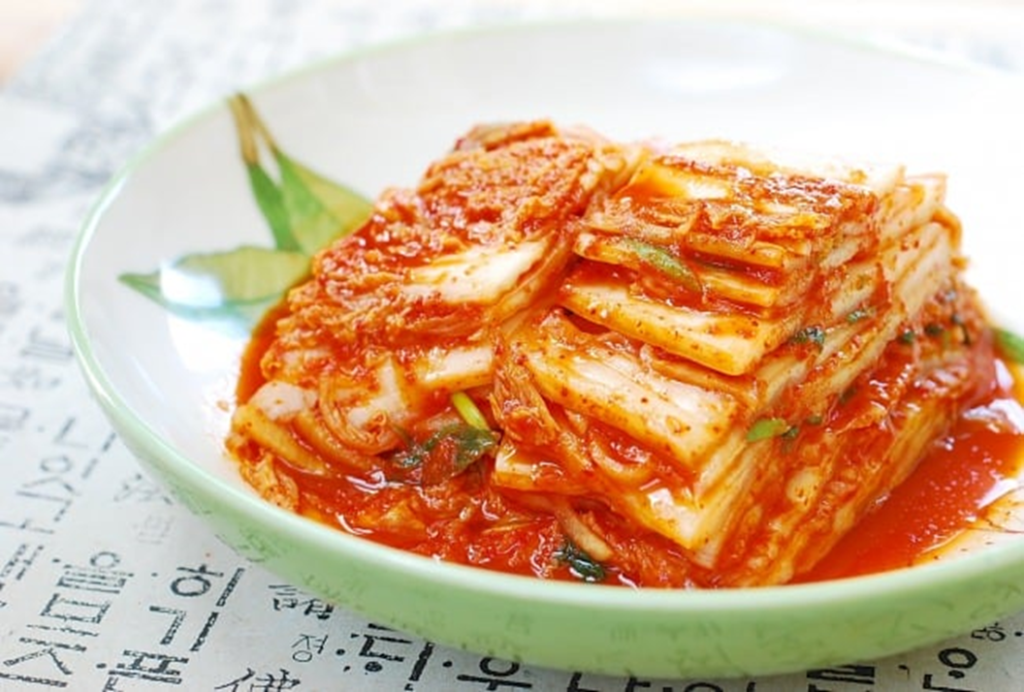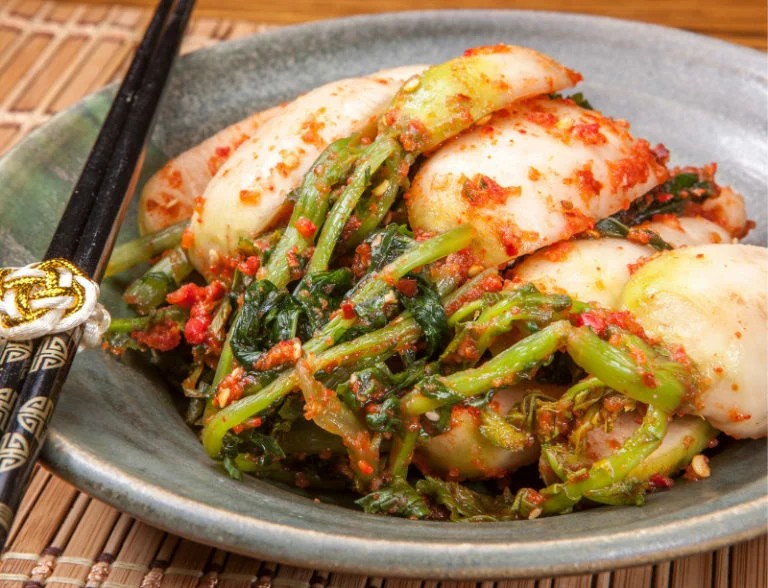The traditional Korean dish, kimchi, is being increasingly regarded as a superfood due to its high nutritonal and antioxidant content. Produced by a lacto-fermentation process, kimchi is known to assist gut health, digestion, reduce stress levels and improve the quality of sleep. Frequently served as a side dish, Kimichi is also used in the making of soups and stews with studies indicating that more than 90% of South Koreans eat kimchi every day.
.
Traditionally, kimchi contains cabbage, daikon (Japanese radish), and several herbs such as chili, garlic, ginger, and fish sauce. Kimchi is popular for its rich, fragrant, spicy, and tangy taste. It is a combination of different ingredients that many find addictive. As the flavor of kimchi is described as sour, pungent, salty, spicy, and even umami, it is no surprise to see it in every meal of its home country, as well as intriguing the taste buds of diners all around the world.
History of kimchi

Kimchi’s origins date back to Korea’s Three Kingdoms period between the first century AD and the sixth century AD. Cabbage first came to Korea in around 2030 BC. Families had used methods to preserve vegetables in harsh Korean winters, so the nutrients in the vegetables would remain preserved. Kimchi was contributing to all the basic needs of Koreans. Farmers would preserve their crops in kimchi, especially vegetables, which were piled up with salt in sandstone jars (onggi) and buried. Crops would remain preserved with fermentation and cold.
This preserved cabbage dish went through various guises until the 16th century when chili peppers and various spices came from America. This paved the way for a huge variety of the hot and tangy recipes that we know today.
Simple vegetables and salt were among the first ingredients in kimchi. As time passed, different ingredients like garlic and chili pepper were added to kimchi, leading to what we have today.
How is kimchi made?

When it comes to making kimchi, there are several kinds, and the best place is to start with simple kimchi.
Lacto Fermentation is a process used to make cabbage kimchi.
Step 1: Soak nappa cabbage in a salty brine to kill any harmful bacteria.
Step 2: Good bacteria (Lactobacillus) will be left that convert sugars into lactic acid. It preserves the vegetables, giving them a tangy flavor.
This lacto-fermentation process is similar to creating sauerkraut and traditional dill pickles.
There are different takes on sweetening kimchi because some use a little bit of sugar while others totally shun sweeteners. A basic recipe calls for the following ingredients:
- Napa cabbage
- Salt
- Garlic
- Ginger
- Sugar
- Scallions
- Gochugaru (Korean red pepper flakes)
- Fish sauce or shrimp paste
Eventually, you can make your kimchi at home personally customised to your taste.
Kimchi Recipes
There are a variety of kimchi recipes besides the basic one. Here are a few more kimchi recipes:
Vegan kimchi

In vegan kimchi, instead of salted and fermented seafood, it is cooked using soup soy sauce (gukganjang, 국간장) or sometimes fermented soybean paste (doenjang, 된장), and dashima (다시마, dried kelp) or vegetable broth. For sweetness, natural sweeteners like fruits and vegetables such as Korean pear, apple, persimmon, pumpkin, etc. are commonly added.
This vegan kimchi is inspired by temple kimchi. Garlic and scallions are among the forbidden vegetables in temple kimchi. It takes an hour to prepare this kimchi. Ingredients used in the dish include:
- 1 large napa cabbage, about 5 pounds
- 3 stalks of scallions
- 1 cup Korean coarse sea salt
- 3 large mustard greens, gat (갓), leaves
- 3/4-pound Korean radish mu/moo
All ingredients are seasoned with:
- 1 tablespoon glutinous rice sweet rice powder
- 1/2 cup Korean red chili pepper flakes gochugaru
- 1/4 Korean pear grated
- 1/2 cup pumpkin puree, any orange flesh pumpkin
- 2 tablespoons minced garlic
- 1 teaspoon grated ginger
- 2 tablespoons soup soy sauce
- 2 tablespoons salt, or to taste
- 1 cup dashima-dried kelp broth
Baechu Geotjeori (fresh kimchi)

Geotjeori is eaten without fermentation, which develops a natural sweetness. Ingredients used include:
- 1 small, about 2.5 pounds, baechu
- 3 tablespoons of coarse sea salt
- 2 scallions
- 2 ounces buchu garlic chives mashed into 2 inch pieces
- A few stalks of Minari water dropwort
The ingredients are seasoned with:
- Korean red chili pepper flakes 4 tablespoon
- Fish sauce 3 tablespoons
- Corn syrup 1 tablespoon
- Korean plump syrup 1 tablespoon
- Minced garlic 1 tablespoon
- Finely grated ginger 1 teaspoon
- Sesame seeds 1 teaspoon
How beneficial Is kimchi?

Nutrient Density: Kimchi contains lots of nutrients in a low-calorie pack. Chinese cabbage is one of the main ingredients used in the kimchi and singlehandedly contains vitamins A and C, at least 10 different minerals, and over 34 amino acids.
Since kimchi varies in ingredients, predicting its exact nutritional profile is difficult based on different batches and brands. All the same, a 1-cup (150-gram) serving boasts:
- Calories: 23
- Carbs: 4 grams
- Protein: 2 grams
- Fat: less than 1 gram
- Fibre: 2 grams
- Sodium: 747 mg
- Iron: 21% of the DV
- Niacin: 10% of the DV
- Riboflavin: 24% of the DV
- Vitamin B6: 19% of the Daily Value (DV)
- Vitamin C: 22% of the DV
- Vitamin K: 55% of the DV
As green vegetables are good sources of nutrients like vitamin K and riboflavin, you can choose from several green veggies, such as cabbage, celery, and spinach.
Contains probiotics: The lacto-fermentation process that kimchi undergoes makes it unique. Fermented foods have an extended shelf life and enhanced taste and aroma. When taken as a supplement, this bacterium may provide several health benefits, like treating hay fever and certain types of diarrhea. Probiotics in kimchi are linked to the prevention and treatment of several conditions, including:
- Mental health
- Skin health
- Heart health
- Gastrointestinal health
- Constipation
- Common Cold
Kimchi may:
Strengthen your immune system: The Lactobacillus bacterium may boost your immune system. Studies show isolated Lactobacillus plantarum from kimchi has immune-enhancing effects. These results are promising; still, more research is needed.
Reduce inflammation: Probiotics and active compounds in kimchi may help to reduce inflammation. Studies done on mice have shown promising results. However, human studies are lacking.
Help to slow aging: Chronic inflammation doesn’t just cause numerous illnesses but also accelerates the aging process. Kimchi can possibly prolong cell life by slowing this process. In a test-tube study, human cells treated with kimchi demonstrated increased viability, leading to a longer overall cell life and an extended life span regardless of their age. Though the results are promising, many more studies are required before kimchi is recommended for use to slow the aging process.
Aid weight loss: Fermented foods like kimchi from Korea and pickles from India, Pakistan, and Bangladesh are both low in calories and may boost weight loss. A 4-week study done on 22 people with excess weight found that eating fresh or fermented kimchi helped them gain health benefits, including:
- Reduced body weight
- Reduced body mass index (BMI)
- Reduced body fat
- Decreased blood sugar levels
These results were shown against those who ate the fresh dish, especially improvements in blood pressure and body fat percentage. Though it’s unclear whether kimchi is responsible for weight loss effects, its low-calorie count, high fibre content, and probiotics are promising factors that can play a role in battling obesity.
Support gut health: There is evidence that kimchi can improve beneficial bacteria in the gut. Including kimchi as pickles, like fermented foods, in the diet may improve intestinal health.
Kimchi consumption figures: Korea, USA, UK, AUS

Kimchi is the fermented and pickled form of various vegetables. It achieved new popularity levels during the pandemic when it was stated in several reports that fermented food like kimchi strengthens disease immunity.
Korea is reportedly consuming 1.85 million metric tons of kimchi annually, which accounts for 36.1 kg per person. Between 2020 and 2022, Korea imported 700,000 tons of foreign kimchi, valued at $450,000. In terms of exports, Japan was the leading country, with around 61 million U.S. dollars worth of kimchi exported to Japan that year. The following destinations are the US, UK, and Netherlands.
South Korean kimchi exports saw a rise of 7.1% from 42,544 tons exported in 2021 to 44,041 tons in 2023. The United States singlehandedly imported more than 10,000 tons of kimchi in 2023 from Korea.

The British have also gone crazy about the taste of kimchi. Fermented Korean staple exports stood at 656 metric tons (worth £2.1 million) in 2019 and rose by 23% to 886 metric tons (worth £2.5 million) by September 31, 2020, as per reports from the Korea Agro-Fisheries & Food Trade Corporation.
In 2022, South Korea exported around 5.88 million U.S. dollars worth of Kimchi to Australia, up from about 5.13 million U.S. dollars in the previous year, according to Statista. Kimchi exports to Australia have continued to increase in recent years.
All these riding trends are predicting how popular kimchi is for its wellness and taste factors. Supermarkets have been seeing these trends, especially since the pandemic. In recent times, suppliers have begun to tweak the dish to make it more appealing to a wider customer base.
Conclusion
Kimchi is an excellent source of several health benefits and can be made easily at home from several recipes. The dish remains a traditional staple of Korean cuisine but is evolving to suit consumers in different parts of the world, eager to partake of the wellness benefits of the dish. With one to three servings a day linked to lower levels of obesity, the food is also popular with those looking to reduce body fat. Start with the basic recipe, get hold of a Chinese cabbage, spices and other ingredients and, after the preservation period, you will soon you have your own delicious kimchi. A dish, it seems, that the world cannot get enough of today.






